EDUCATORI want to be a good teacher.
I want to connect with the children.
I want to enrich their lives.
I want to develop their skills.
I want class to go smoothly.
I want to have fun.
I want the parents to get their money’s worth.
I want the parents and children to like me.
I want them to re-enroll.
I want to feel successful.
CHILD
I want to give love.
I want to be loved.
I want to be noticed.
I want to be accepted.
I want to be engaged.
I want to have fun.
I don’t want to make mistakes.
I’m leery of new people.
I’m sometimes afraid to try something new.
I want to have friends.
I want to learn.
I want to move.
I want to be close to Mommy/Daddy.
I want to be independent.
I want to do it myself.
PARENTI love my child more than anything in the world.
I am an expert on my child.
I want the very best for my child.
I am doing the absolute best I can.
I often feel insecure.
I delight in my child’s successes.
I’m impacted by everything my child does.
I sometimes feel alone.
I frequently feel overwhelmed.
I need to feel supported.
I need you to love and accept my child.
I feel judged as a parent by the actions of my child.
I want the other parents to like me.
I want to connect with the children.
I want to enrich their lives.
I want to develop their skills.
I want class to go smoothly.
I want to have fun.
I want the parents to get their money’s worth.
I want the parents and children to like me.
I want them to re-enroll.
I want to feel successful.
CHILD
I want to give love.
I want to be loved.
I want to be noticed.
I want to be accepted.
I want to be engaged.
I want to have fun.
I don’t want to make mistakes.
I’m leery of new people.
I’m sometimes afraid to try something new.
I want to have friends.
I want to learn.
I want to move.
I want to be close to Mommy/Daddy.
I want to be independent.
I want to do it myself.
PARENTI love my child more than anything in the world.
I am an expert on my child.
I want the very best for my child.
I am doing the absolute best I can.
I often feel insecure.
I delight in my child’s successes.
I’m impacted by everything my child does.
I sometimes feel alone.
I frequently feel overwhelmed.
I need to feel supported.
I need you to love and accept my child.
I feel judged as a parent by the actions of my child.
I want the other parents to like me.
 I am the mom of 4 wonderful kids, 3 boys and 1 girl. Looking at them, you know I have had many years working with and enriching the lives of children. I have an Associates (Magna Cum Laude) in Business Management, and a Bachelors in Early childhood Development and Education with a concentration in Child Psychology. I have almost 20 years in the Early Childhood field, and loving every minute of it! You can visit my site here
I am the mom of 4 wonderful kids, 3 boys and 1 girl. Looking at them, you know I have had many years working with and enriching the lives of children. I have an Associates (Magna Cum Laude) in Business Management, and a Bachelors in Early childhood Development and Education with a concentration in Child Psychology. I have almost 20 years in the Early Childhood field, and loving every minute of it! You can visit my site here














